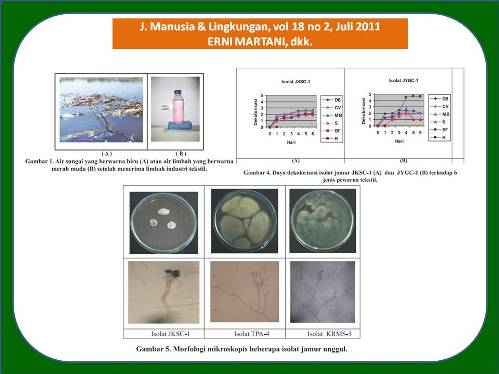
ISOLASI DAN KARAKTERISASI JAMUR PENDEGRADASI ZAT PEWARNA TEKSTIL (Isolation and Characterization of dye-degrading Fungi)
Erni Martani(1*), Sebastian Margino(2), Elisa Nurnawati(3)
(1) Program Studi Mikrobiologi, Fakultas Pertanian, Universitas Gadjah Mada
(2) Program Studi Mikrobiologi, Fakultas Pertanian, Universitas Gadjah Mada
(3) Jurusan Biologi, Fakultas MIPA, Universitas Sriwijaya, Palembang
(*) Corresponding Author
Abstract
ABSTRAK
Industri tekstil tidak saja menghasilkan sandang yang merupakan kebutuhan primer manusia, tetapi juga mengeluarkan limbah yang berpotensi sebagai penyebab pencemaran lingkungan. Komponen utama limbah industri ini adalah berbagai jenis zat pewarna tekstil. Penelitian ini bertujuan untuk memperoleh isolat-isolat jamur yang mampu mendegradasi beberapa jenis zat pewarna tekstil. Isolasi dilakukan menggunakan metode surface plating di atas medium Potato Dextrose Agar, dan seleksi kemampuan degradasi pewarna berdasarkan atas toleransi terhadap konsentrasi zat pewarna, serta besar dan kecepatan dekolorisasi beberapa jenis zat pewarna. Sebagai parameter awal digunakan enam zat pewarna tekstil. Isolat-isolat unggul kemudian diidentifikasi awal berdasar atas morfologi mikroskopis terhadap miseliumnya. Dalam penelitian ini juga digunakan beberapa kultur murni jamur pembusuk putih sebagai pembanding. Dalam penelitian ini digunakan limbah cair dan padat beberapa industri tekstil dan industri pulp & paper, tanah gambut dari Kalimantan Tengah dan Riau, tanah sekitar Tempat Pembuangan Sampah Akhir, serta tanah seresah hutan. Dari berbagai sumber tersebut diperoleh 101 isolat jamur. Uji dekolorisasi kualitatif terhadap 6 zat pewarna menghasilkan 6 isolat unggul yang mampu mendekolorisasi lebih dari tiga jenis pewarna dengan kecepatan relatif tinggi. Masing-masing isolat unggul memiliki spesifikasi dalam daya dekolorisasi terhadap ke 6 jenis pewarna. Identifikasi awal terhadap isolat unggul menunjukkan bahwa mereka berasal dari genus Aspergillus, Cladosporium, Penicillium dan Stachybotrys. Sedangkan uji terhadap kultur jamur pembusuk putih sebagai pembanding menghasilkan 2 kultur unggul, yaitu: Phanerochaete chrysosporium dan Pleurotus ostreatus. Secara umum kemampuan dekolorisasi isolat-isolat jamur kebanyakan masih di bawah kemampuan kedua kultur murni tersebut, namun beberapa isolat justru memiliki kemampuan lebih tinggi dibandingkan kultur pembanding.
ABSTRACT
The aim of this study was to isolate textile dye degrading fungi from many kinds of sample. Isolation was done using surface plating method on Potato Dextrose Agar medium. Degradation ability was measured based on dye decolorization of agar medium. The selection of isolates was based on ability to decolorize some types of dye, rate of decolorization, and tolerance to dye concentration, respectively. Six kinds dye, namely Basic fuchsin, Crystal violet, Direct blue, Methylene blue, Rhodamine B, and Safranine were used in this study. Six species of lignin degrading white rot fungi were used as positive controls. More than 100 fungal strains could be isolated from waste water and solid wastes of textile and pulp & paper industries, peat soils from Central Kalimantan and Riau, and forest soil. Examination on dye decolorization resulted in 6 selected isolates (coded as JKNT-1, JKSC-1, KRMS 5, TPA-4, TPA-10, and JYGC-1; and 2 species of lignin degrading white rot fungi, namely Phanerochaete chrysosporium and Pleurotus ostreatus. Decolorization of dye was depended on the fungal species and type of dye, i.e. one species decolorized some dyes but not the others. Methylene Blue was decolorized more readily than other dyes. In general, dye decolorization activity of fungal isolates was lower than the lignin degrading fungi. Microscopic examination indicated that the isolates of JKNT 1 and KRMS-5 were come from the genus Penicillium, the genus of JKSC-1 was Stachybotrys, the TPA-4 and JYGC-1 were Cladosporium, and TPA-10 isolate was included in genus of Aspergillus.
Full Text:
Artikel lengkap (PDF) (Bahasa Indonesia)Article Metrics
Refbacks
- There are currently no refbacks.
Copyright (c) 2017 Jurnal Manusia dan Lingkungan







